Behringer 904A Voltage Controlled Low Pass Filter Handleiding
Behringer
Synthesizer
904A Voltage Controlled Low Pass Filter
Bekijk gratis de handleiding van Behringer 904A Voltage Controlled Low Pass Filter (11 pagina’s), behorend tot de categorie Synthesizer. Deze gids werd als nuttig beoordeeld door 88 mensen en kreeg gemiddeld 4.7 sterren uit 44.5 reviews. Heb je een vraag over Behringer 904A Voltage Controlled Low Pass Filter of wil je andere gebruikers van dit product iets vragen? Stel een vraag
Pagina 1/11

Quick Start Guide
Controls
(1) FIXED CONTROL VOLTAGE – Also referred to as “cuto
frequency”, this knob manually determines the frequency
above which frequencies are attenuated. The resulting
frequency will depend on this knob’s setting as well as
voltage received from the control inputs.
(2) FREQUENCY RANGE – Select one of 3 frequency bands
in which the xed control voltage operates. Position 1 is
1 Hz to 5 kHz, position 2 is 4 Hz to 20 kHz, and position 3 is
16 Hz to 80 kHz.
(3) REGENERATION – This knob varies the amount of
internal feedback, creating a resonant peak at the cuto
frequency. At higher settings this becomes self-oscillation.
(4) SIGNAL INPUT – Connect the incoming signal via 3.5 mm
TS cable.
(5) SIGNAL OUTPUT – Send the processed signal to another
module via 3.5 mm TS cable.
(6) CONTROL INPUTS – Connect control voltage signals from
other modules to aect the cuto frequency. The sum of
the voltage received doubles the frequency cuto point
for each 1 V increase.
(1)
(3)
(4) (5)
(6)
(2)
Power Connection
The 904A comes with the required power cable for connecting
to a standard Eurorack power supply system. Follow these
steps to connect power to the module. It is easier to make these
connections before the module has been mounted into a rack case.
1. Turn the power supply or rack case power o and
disconnect the power cable.
2. Insert the 16-pin connector on the power cable into the
socket on the power supply or rack case. The connector has
a tab that will align with the gap in the socket, so it cannot
be inserted incorrectly. If the power supply does not have
a keyed socket, be sure to orient pin 1 (-12 V) with the red
stripe on the cable.
3. Insert the 10-pin connector into the socket on the back of
the module. The connector has a tab that will align with the
socket for correct orientation.
4. After both ends of the power cable have been securely
attached, you may mount the module in a case and turn on
the power supply.
Installation
The necessary screws are included with the module for mounting
in a Eurorack case. Connect the power cable before mounting.
Depending on the rack case, there may be a series of xed holes
spaced 2 HP apart along the length of the case, or a track that
allows individual threaded plates to slide along the length
of the case. The free-moving threaded plates allow precise
positioning of the module, but each plate should be positioned in
the approximate relation to the mounting holes in your module
before attaching the screws.
Hold the module against the Eurorack rails so that each of the
mounting holes are aligned with a threaded rail or threaded
plate. Attach the screws part way to start, which will allow
small adjustments to the positioning while you get them all
aligned. After the nal position has been established, tighten the
screws down.
904A VOLTAGE CONTROLLED
LOW PASS FILTER
Legendary Analog Low Pass VCF
Module for Eurorack
V 1.0

Conexión eléctrica
El 904A viene con el cable de alimentación necesario para
conectarse a un sistema de suministro de energía Eurorack
estándar. Siga estos pasos para conectar la alimentación al
módulo. Es más fácil realizar estas conexiones antes de que el
módulo se haya montado en una caja de rack.
1. Apague la fuente de alimentación o la caja del bastidor y
desconecte el cable de alimentación.
2. Inserte el conector de 16 clavijas del cable de alimentación
en la toma de la fuente de alimentación o en la caja del
bastidor. El conector tiene una pestaña que se alineará
con el espacio en el zócalo, por lo que no se puede insertar
incorrectamente. Si la fuente de alimentación no tiene un
enchufe con llave, asegúrese de orientar el pin 1 (-12 V) con
la raya roja en el cable.
3. Inserte el conector de 10 pines en el zócalo en la parte
posterior del módulo. El conector tiene una pestaña que se
alineará con el enchufe para una orientación correcta.
4. Una vez que ambos extremos del cable de alimentación se
hayan conectado de forma segura, puede montar el módulo
en una caja y encender la fuente de alimentación.
Instalación
Los tornillos necesarios se incluyen con el módulo para el montaje en
una caja Eurorack. Conecte el cable de alimentación antes del montaje.
Dependiendo de la caja del bastidor, puede haber una serie de
oricios jos separados 2 HP a lo largo de la caja, o una pista que
permita que las placas roscadas individuales se deslicen a lo largo
de la caja. Las placas roscadas de movimiento libre permiten
un posicionamiento preciso del módulo, pero cada placa debe
colocarse en una relación aproximada con los oricios de montaje
en su módulo antes de colocar los tornillos.
Sostenga el módulo contra los rieles Eurorack de modo que cada
uno de los oricios de montaje esté alineado con un riel o placa
roscada. Coloque los tornillos parcialmente para comenzar, lo
que permitirá pequeños ajustes en la posición mientras los alinea
todos. Una vez establecida la posición nal, apriete los tornillos.
(ES) Controles
(1) VOLTAJE DE CONTROL FIJO – También denominado
“frecuencia de corte”, este mando determina
manualmente la frecuencia por encima de la cual
se atenúan las frecuencias. La frecuencia resultante
dependerá de la conguración de esta perilla, así como del
voltaje recibido de las entradas de control.
(2) RANGO DE FRECUENCIA – Seleccione una de las 3 bandas
de frecuencia en las que opera la tensión de control ja. La
posición 1 es de 1 Hz a 5 kHz, la posición 2 es de 4 Hz a 20
kHz y la posición 3 es de 16 Hz a 80 kHz.
(3) REGENERACIÓN – Esta perilla varía la cantidad de
retroalimentación interna, creando un pico resonante en la
frecuencia de corte. En ajustes más altos, esto se convierte
en autooscilación.
(4) ENTRADA DE SEÑAL – Conecte la señal entrante
mediante un cable TS de 3,5 mm.
(5) SALIDA DE SEÑAL – Envíe la señal procesada a otro
módulo mediante un cable TS de 3,5 mm.
(6) ENTRADAS DE CONTROL – Conecte señales de voltaje
de control de otros módulos para afectar la frecuencia
de corte. La suma del voltaje recibido duplica el punto de
corte de frecuencia por cada aumento de 1 V.
(1)
(3)
(4) (5)
(6)
(2)
2904A VOLTAGE CONTROLLED LOW PASS FILTER

(DE) Bedienelemente
(1) FESTE STEUERSPANNUNG – Dieser Regler wird auch als
„Grenzfrequenz“ bezeichnet und bestimmt manuell die
Frequenz, über der die Frequenzen gedämpft werden.
Die resultierende Frequenz hängt von der Einstellung
dieses Reglers sowie von der von den Steuereingängen
empfangenen Spannung ab.
(2) FREQUENZBEREICH – Wählen Sie eines von 3
Frequenzbändern, in denen die feste Steuerspannung
arbeitet. Position 1 ist 1 Hz bis 5 kHz, Position 2 ist 4 Hz bis
20 kHz und Position 3 ist 16 Hz bis 80 kHz.
(3) REGENERATION – Dieser Regler variier t die interne
Rückkopplung und erzeugt einen Resonanzpeak bei der
Grenzfrequenz. Bei höheren Einstellungen wird dies
zur Selbstschwingung.
(4) SIGNALEINGANG – Schließen Sie das eingehende Signal
über ein 3,5 mm TS-Kabel an.
(5) SIGNALAUSGANG – Senden Sie das verarbeitete Signal
über ein 3,5 mm TS-Kabel an ein anderes Modul.
(6) STEUEREINGÄNGE – Steuerspannungssignale von
anderen Modulen anschließen, um die Grenzfrequenz zu
beeinussen. Die Summe der empfangenen Spannung
verdoppelt den Frequenzabschaltpunkt für jede Erhöhung
um 1 V.
(1)
(3)
(4) (5)
(6)
(2)
Netzanschluss
Der 904A wird mit dem erforderlichen Stromkabel für den
Anschluss an ein Standard-Eurorack-Stromversorgungssystem
geliefert. Befolgen Sie diese Schritte, um das Modul mit Strom
zu versorgen. Es ist einfacher, diese Verbindungen herzustellen,
bevor das Modul in ein Rackgehäuse eingebaut wurde.
1. Schalten Sie das Netzteil oder das Rackgehäuse aus und
ziehen Sie das Netzkabel ab.
2. Stecken Sie den 16-poligen Stecker am Netzkabel in die
Buchse am Netzteil oder im Rack-Gehäuse. Der Anschluss
verfügt über eine Lasche, die an der Lücke in der Buchse
ausgerichtet ist, sodass sie nicht falsch eingeführt werden
kann. Wenn das Netzteil keine Schlüsselbuchse hat, achten
Sie darauf, Pin 1 (-12 V) mit dem roten Streifen am Kabel
auszurichten.
3. Stecken Sie den 10-poligen Stecker in die Buchse auf der
Rückseite des Moduls. Der Anschluss verfügt über eine
Lasche, die zur korrekten Ausrichtung an der Buchse
ausgerichtet wird.
4. Nachdem beide Enden des Netzkabels fest angeschlossen
wurden, können Sie das Modul in einem Gehäuse
montieren und die Stromversorgung einschalten.
Installation
Die erforderlichen Schrauben sind im Lieferumfang des Moduls für
die Montage in einem Eurorack-Gehäuse enthalten. Schließen Sie
das Netzkabel vor der Montage an.
Abhängig vom Rack-Gehäuse kann es eine Reihe von festen
Löchern geben, die entlang der Länge des Gehäuses 2 PS
voneinander entfernt sind, oder eine Schiene, mit der einzelne
Gewindeplatten entlang der Länge des Gehäuses gleiten können.
Die frei beweglichen Gewindeplatten ermöglichen eine präzise
Positionierung des Moduls. Jede Platte sollte jedoch in der
ungefähren Beziehung zu den Befestigungslöchern in Ihrem
Modul positioniert werden, bevor Sie die Schrauben anbringen.
Halten Sie das Modul so gegen die Eurorack-Schienen, dass jedes
der Befestigungslöcher mit einer Gewindeschiene oder einer
Gewindeplatte ausgerichtet ist. Bringen Sie die Schrauben teilweise
an, um zu beginnen. Dadurch können Sie die Position geringfügig
anpassen, während Sie alle ausrichten. Ziehen Sie die Schrauben
fest, nachdem die endgültige Position festgelegt wurde.
4904A VOLTAGE CONTROLLED LOW PASS FILTER
Product specificaties
| Merk: | Behringer |
| Categorie: | Synthesizer |
| Model: | 904A Voltage Controlled Low Pass Filter |
Heb je hulp nodig?
Als je hulp nodig hebt met Behringer 904A Voltage Controlled Low Pass Filter stel dan hieronder een vraag en andere gebruikers zullen je antwoorden
Handleiding Synthesizer Behringer
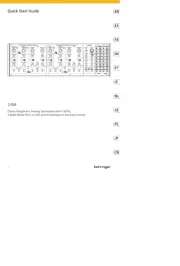
4 Juni 2025
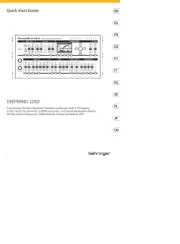
1 April 2025
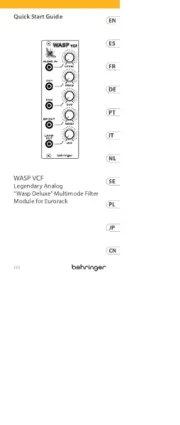
1 April 2025
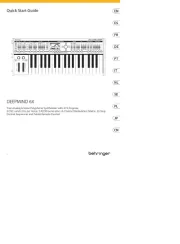
1 April 2025
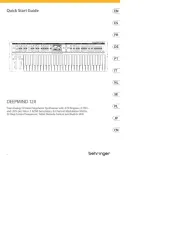
1 April 2025
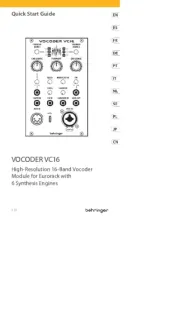
1 April 2025
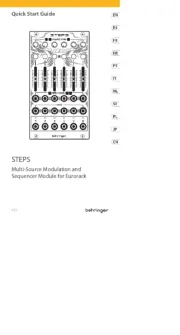
30 Januari 2025

2 Januari 2025
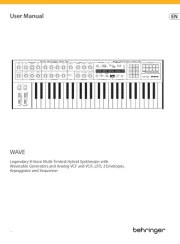
2 Januari 2025

2 Januari 2025
Handleiding Synthesizer
- Pioneer
- Dreadbox
- Native
- Sequential
- Roland
- Omnitronic
- Flame
- Arturia
- Korg
- Ferrofish
- LennarDigital
- Studiologic
- Yamaha
- (Recovery)
- Kodamo
Nieuwste handleidingen voor Synthesizer

3 September 2025
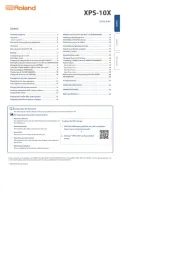
1 September 2025

30 Juni 2025
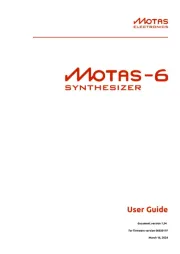
10 Juni 2025
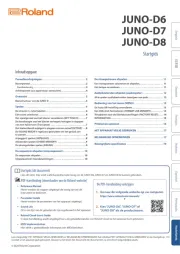
16 Mei 2025
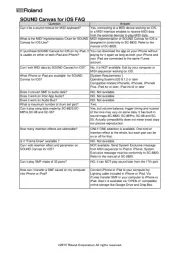
13 Mei 2025

13 Mei 2025
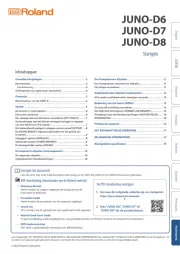
12 Mei 2025

12 Mei 2025
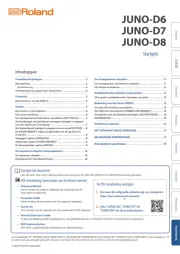
12 Mei 2025